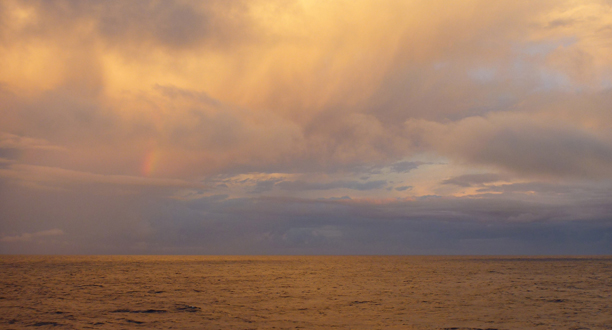50 Ways to Get Hurt

On board the Mermaid Sapphire steaming from Sydney, Australia, to Rabaul, Papua New Guinea
I’ve spent the past year thinking about the risks inherent in a complex expedition like this. On a working ship testing a new sub there are 50 ways to be hurt or worse. As soon as you step through a hatchway into the sunlight you have to be careful of heaving decks, falling and swinging objects, and cables under tension. If you’re a scuba diver helping recover the sub, you have to protect yourself against the moving mass of the sub and overly taut tag lines. If you’re inside the sub’s crew sphere, you have to be vigilant about electrical fires, hypothermia, and carbon dioxide poisoning.
This morning at sunrise we’re 40 miles (64 kilometers) east of the southern end of the Great Barrier Reef, 841 miles (1,353 kilometers) north of Sydney, and 1,088 miles (1,751 kilometers) south of our destination of Rabaul. Ocean swells coming from our stern quarter continue to push us north.
At 6:30 breakfast, a sub team member describes a pain in the back of his neck that kept him awake most of the night. He isn’t complaining or asking for treatment; he’s just sharing information. He tells me that he doesn’t mind the pain; he figures it’s the cost of long hours spent in confined spaces doing precision electronic work on a rolling ship. Being modest about such things, he leaves out a big part of the story. For the last six months he’s worked on a series of challenging electronic problems against constantly shifting deadlines. Like all of his teammates, he’s logged an uncounted number of 20-hour days. He’s sleep deprived; his physical batteries are drained.
Chronic sleep deprivation adversely affects our brains. It leads to high blood pressure, memory loss, and poor judgment. It increases our anxiety and aggression. We have to be careful. We have a new sub and a new team going up against an ancient, malevolent ocean. Fortunately, since we left Sydney, everyone has been sleeping well.
At 6 p.m., after 11 hours of work on the sub, we go to the upper forecastle deck, where David Wotherspoon and Captain Stu Buckle have organized a barbecue dinner. There are delicious steaks and steaming potatoes. There are cold beers and animated conversations backlit by a smooth-water sunset over the Great Barrier Reef.
Just before the sun leaves the sky it illuminates a massive cloud in front of the ship. Without warning, a small, curved rainbow appears near its base. The rainbow remains for almost an hour, glowing and unwavering. Far to the south, in Melbourne, hundreds of family and friends spent the afternoon at Andrew Wight’s funeral. For all of us watching from the foredeck, the arc of color suspended in the sky is a benediction for a man we loved.
There are 52 good men on this ship. Twenty-three belong to the ship’s crew of officers, engineers, oilers, and seamen. Twenty-nine make up the expedition team of electronic and mechanical specialists, filmmakers, divers, and small-boat drivers. They’re strong men with hundreds of years of seagoing experience among them. A few have seen military combat. They enjoy being part of a once-in-a-century deep-sea expedition. But I suspect that when it comes to high-end risk-taking, they’ll be as cautious as grandmothers.
Photograph by Joe MacInnis



